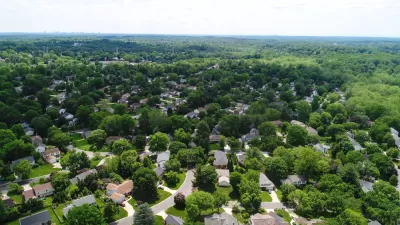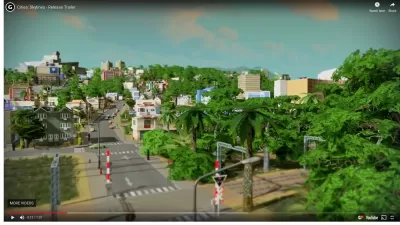Norman Chan uses a beta version of the new SimCity game to test the merits of three familiar types of suburban subdivision design - a rectangular grid, circular sprawl, and cul-de-sacs.

"The metric that matters the most in SimCity is population," explains Chan, in his review of a beta version of the game which is due out in March. "The higher the population, the more successful you are. But moreso than any other game in the series before it (at least in this beta), population is dictated by road design and placement. That's why for the first time, SimCity not only lets you build a wide range of road types (from dirt road to wide avenues), but also curved roads in addition to straight ones."
Over an hour of game play a piece, Chan oberves how much population growth and redevelopment potential is possible in each of three street design types. The orthoganal grid layout fared the worst, with "radiating sprawl" faring better.
"Cul-de-sac design turned out to be the most successful of the layouts I tried, letting me reach over 20,000 population in just half an hour of play. The generous spacing between the cul-de-sacs allowed houses to be upgraded to medium and large-sized homes quicker, though they never converted to apartment complexes in my run. Like with the other designs, I ran out of space well before the hour was up, and found it much more difficult to destroy and rearrange streets without disrupting many cul-de-sacs at once. It was also more difficult to add recreational parks and fountains in this layout, since some structures required much more space than these curling roads could allow."
"SimCity may be just a game, but it's interesting to see how the simulator responds to real-world suburban design scenarios. Players will have to strike a balance between optimizing for 'the game' and building something that's aesthetically pleasing and conducive to their own gaming narrative. I can't wait to see what layouts hardcore SimCity players do to optimize population density, though I don't expect to see any six million population Magnasanti builds any time soon."
FULL STORY: SimCity vs. The Suburban Sprawl

Maui's Vacation Rental Debate Turns Ugly
Verbal attacks, misinformation campaigns and fistfights plague a high-stakes debate to convert thousands of vacation rentals into long-term housing.

Planetizen Federal Action Tracker
A weekly monitor of how Trump’s orders and actions are impacting planners and planning in America.

In Urban Planning, AI Prompting Could be the New Design Thinking
Creativity has long been key to great urban design. What if we see AI as our new creative partner?

Portland Raises Parking Fees to Pay for Street Maintenance
The city is struggling to bridge a massive budget gap at the Bureau of Transportation, which largely depleted its reserves during the Civd-19 pandemic.

Spokane Mayor Introduces Housing Reforms Package
Mayor Lisa Brown’s proposals include deferring or waiving some development fees to encourage more affordable housing development.

Houston Mayor Kills Another Bike Lane
The mayor rejected a proposed bike lane in the Montrose district in keeping with his pledge to maintain car lanes.
Urban Design for Planners 1: Software Tools
This six-course series explores essential urban design concepts using open source software and equips planners with the tools they need to participate fully in the urban design process.
Planning for Universal Design
Learn the tools for implementing Universal Design in planning regulations.
Gallatin County Department of Planning & Community Development
Heyer Gruel & Associates PA
JM Goldson LLC
City of Camden Redevelopment Agency
City of Astoria
Transportation Research & Education Center (TREC) at Portland State University
Jefferson Parish Government
Camden Redevelopment Agency
City of Claremont




























